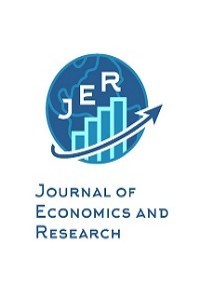AVRUPA BİRLİĞİ’NDE MALİ KOORDİNASYON: İSTİKRAR VE BÜYÜME PAKTI VE REFORMLARI
Avrupa Birliği, İstikrar ve Büyüme Paktı, Maliye Politikası
FISCAL COORDINATION IN EUROPEAN UNION: STABILITY AND GROWTH PACT AND REFORMS
European Union, Stability and Growth Pact, Fiscal Policy,
___
- Annett, A. ve Jaeger, A. (2004). Europe’s Quest For Fiscal Discipline, Finance And Development, June 2004, 22-25.
- Archick, K. (2017). The European Union: Current Challenges And Future Prospects, Congressional Research Service, 7-5700, 1-21.
- Burret, H. T. ve Schnellenbach, J. (2013), Implementation Of The Fiscal Compact In The Euro Area Member States, German Council Of Economic Experts Working Paper 08/2013, 1-51.
- Claeys, G. vd. (2016). A Proposal To Revive The European Fiscal Framework, Bruegel Policy Contribution, Issue 2016/7, 1-20.
- European Commission. (2017). Vade Mecum On The Stabilityand Growth Pact, EC Economic And Financial Affairs, Institutional Paper 052, 1-224
- European Commission. (2016). Specifications On The Implementation Of The Stability And Growth Pact And Guidelines On The Format And Content Of Stability And Convergence Programmes. https://ec.europa.eu/economy_finance/economic_governance/sgp/pdf/coc/code_of_conduct_en.pdf (Erişim Tarihi: 22.08.2020).
- European Commission. (2015). Making The Best Use Of The Flexibility Within The Existing Rules Of The Stability And Growth Pact, Strasbourg, 13.1.2015 COM(2015) 12 Final Provisional.
- European Commission. (2013a). Building A Strengthened Fiscal Framework In TheEuropeanUnion: A Guide To The Stability And Growth Pact, European Economy Occasional Paper 150, 1-35.
- European Commission. (2013b). ‘Two-Pack’ Completes Budgetary Surveillance Cycle For Euro Area And Further Improves Economic Governance, MEMO/13/196.
- Fantacone, S. vd. (2015). European Fiscal Stance: Between Rigidity And Rigid Flexibility, Italian Fiscal Policy Review, 109-122. http://romatrepress.uniroma3.it/ojs/index.php/fiscal/article/view/818/812 (Erişim Tarihi: 15.08.2020).
- Haan, J, vd. (2013). How To Enforce Fiscal Discipline In EMU: A Proposal, SwissSociety Of Economics And Statistics, Vol. 149 (2), 205–217.
- Heinemann, F., vd. (2014). Fiscal Rules And Compliance Expectations- Evidence For The German Debt Brake, ZEW Discussion Paper No. 14-034, 1-36.
- Koester, G.B. vd. (2013). The New EU Fiscal Governance Framework: A Quantum Leap Or Only Small Steps Ahead?, 10th Euroframe Conference On Economic Policy Issues In The European Union, Warsaw, 1-42.
- Maastricht Antlaşması, (1992). https://europa.eu/european-union/sites/europaeu/files/docs/body/treaty_on_european_union_en.pdf (Erişim Tarihi: 22.08.2020).
- Moriıs, R. vd. (2006). The Reform AndImplementation Of The Stability And Growth Pact, European Central Park, OccasionalPaper Series No. 47 / June 2006.
- Ngai, V. (2012). Stability And Growth Pact And Fiscal Discipline In The Eurozone, ss.1-91. https://fic.wharton.upenn.edu/wp-content/uploads/2016/11/12-10.pdf (Erişim Tarihi: 20.08.2020).
- Płóciennik, S. (2017). Rebalancing The Fiscal Framework In The European Union: Perspectives Of Germany, France And Poland, The Polish Institute Of International Affairs Reporti, 1-42.
- Puiu, C. (2013). The Structural Deficit-A New Measure For Fiscal Discipline In The Euro Area, The USV Annals of EconomicsandPublic Administration, Volume 13, 2(18), 174-172.
- Schuknecht, L. vd. (2011). The Stability And Growth Pact Crisis And Reform, European Central Bank Occasional Paper Series No. 129/September 2011. https://www.ecb.europa.eu/pub/pdf/scpops/ecbocp129.pdf (Erişim Tarihi: 11.08.2020).
- Soukiazis, E. ve Castro, V. (2003). The Impact Of The Maastricht Criteria And The Stability And Growth Pact On Growth And Unemployment In Europe, CEUNEUROP Discussion Paper No. 15, 1-33.
- https://europa.eu/european-union/about-eu/history (Erişim Tarihi: 21.08.2020).
- https://www.imf.org/external/pubs/ft/weo/2018/01/weodata/index.aspx (Erişim Tarihi: 22.08.2020).
- https://ec.europa.eu/info/business-economy-euro/economic-and-fiscal-policy-coordination_en (Erişim Tarihi: 20.08.2020).
- https://ec.europa.eu/eurostat/en/data/database (Erişim Tarihi: 22.08.2020).
- https://ec.europa.eu/commission/presscorner/detail/en/IP_15_3220 (Erişim Tarihi: 20.08.2020).
- ISSN: 2717-9907
- Yayın Aralığı: Yılda 2 Sayı
- Başlangıç: 2020
- Yayıncı: Avrasya Sosyo-Ekonomik Araştırmalar Derneği (ASEAD)
LUCAS PARADOKSUNUN SEÇİLMİŞ GELİŞMEKTE OLAN ÜLKELER AÇISINDAN GEÇERLİLİĞİNİN ARAŞTIRILMASI
Harun BAL, Berk PALANDÖKENLİER, Esma ERDOĞAN
AVRUPA BİRLİĞİ’NDE MALİ KOORDİNASYON: İSTİKRAR VE BÜYÜME PAKTI VE REFORMLARI
DAHİLDE İŞLEME REJİMİ KAPSAMINDA YAPILAN İŞLEMLERİN TÜRKİYE EKONOMİSİNE ETKİSİ: GAZİANTEP İLİ ÖRNEĞİ
TÜRKİYE’NİN G-20 ÜLKELERİNE İHRACATININ ÇEKİM MODELİYLE İNCELENMESİ
Seyhan TAŞ, Burak UĞUR, Dilek ATILGAN
TÜRKİYE’DE İLAÇ SEKTÖRÜNÜN GELİŞİMİ; BİR DURUM DEĞERLENDİRMESİ
